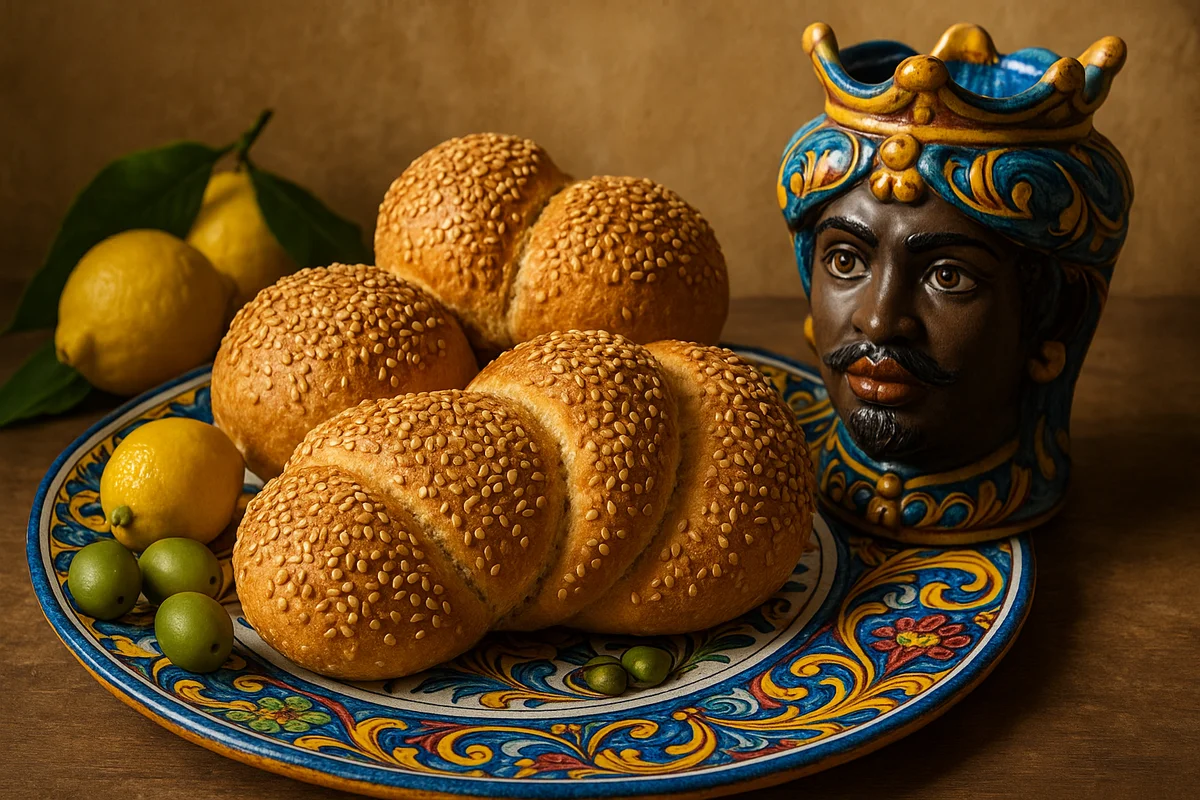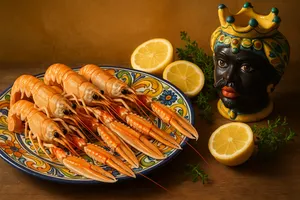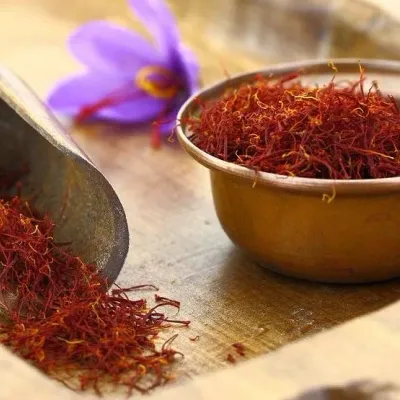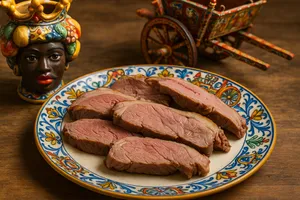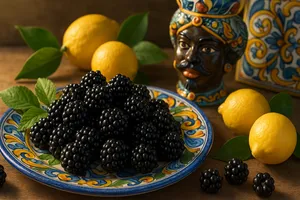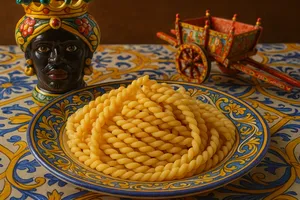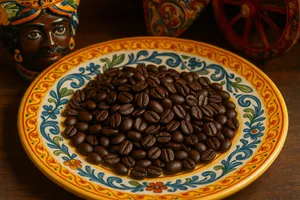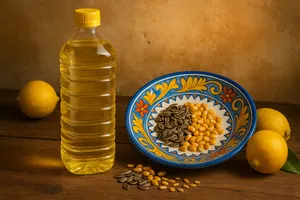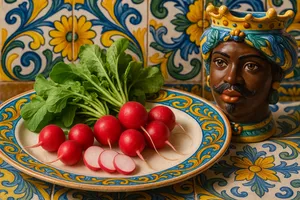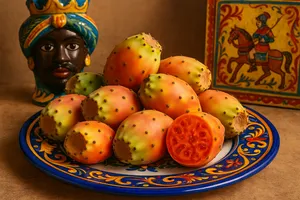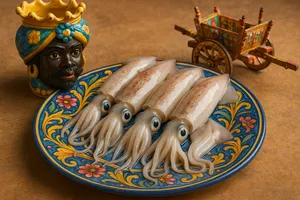Overview
Bread, known in Sicilian simply as “pani”, is the fundamental and sacred food of Sicilian cuisine and culture, made for millennia with durum wheat flour, water, yeast (sourdough or brewer’s yeast) and salt. In Sicily, bread is not only nourishment but a symbol of civilisation, labour, sharing and respect. It has accompanied the island’s history, fed generations and still holds a central role in daily life. Sicilian breadmaking boasts an extraordinary wealth of shapes, types and preparations, each linked to specific regions, occasions and festivals.
Traditional Sicilian bread is distinguished by the predominant use of re-milled durum wheat semolina, which gives a golden-yellow colour, intense flavour, thick crunchy crust, and a compact, fragrant crumb. Every area of Sicily has its characteristic shapes: bread from Castelvetrano, the Dittaino loaf, mafalda, cuḍḍura, vastella and dozens of other varieties. Bread was (and is) baked in wood-fired ovens, where it acquires its unmistakable aroma and perfect crust. Respect for bread runs deep: wasting it is considered a serious fault, and stale bread has countless uses in the kitchen. Sicilian bread is an intangible heritage of the island, an expression of identity and tradition.
Characteristics of Sicilian bread
Traditional Sicilian bread has a thick, crisp, golden crust, often decorated with sesame seeds. The crumb is compact yet soft, straw-yellow in colour due to the use of durum wheat semolina, with medium alveoli and an intense aroma. The flavour is robust, savoury, with notes of toasted grain. It remains fresh for 2–3 days with good quality, then becomes dry but still usable. Its shape varies: round loaves, batons, and elaborate forms for special occasions.
Traditional ingredients
Sicilian bread is made with re-milled durum wheat semolina (or a blend with soft wheat flour), water, sourdough (traditional) or brewer’s yeast (modern), and salt. Some variations add extra-virgin olive oil, sesame seeds (very common) or malt for colour. Durum wheat semolina imparts the typical characteristics of Sicilian bread: yellow hue, intense flavour, superior keeping quality.
Main types of Sicilian bread
Pane di Castelvetrano DOP
Produced in the Castelvetrano area (province of Trapani) with DOP designation. It has the shape of a large loaf called “vastedda”, a golden-yellow crust sprinkled with sesame seeds, and a compact, intensely yellow crumb. It is one of the most famous and prized Sicilian breads, with a distinctive flavour and excellent keeping qualities.
Pagnotta del Dittaino DOP
Produced in the Dittaino River area (provinces of Enna and Catania). It has a flattened round shape, thick dark yellow crust and compact golden-yellow crumb. It is made with local durum wheat semolina and sourdough, baked in wood-fired ovens. It has held DOP status since 2009.
Mafalda
Bread with a characteristic shape featuring “ears” on the sides, sprinkled with sesame seeds, typical of the Palermo area. It has a soft, fluffy crumb and thin crust. Ideal for sandwiches.
Cuḍḍura
A ring- or crown-shaped bread, traditional for festive occasions. It may be decorated, sprinkled with sesame seeds and used in ceremonies (weddings, Easter).
Vastella
A small individual bread with a rounded, plump shape, typical of western Sicily. Ideal for single servings or sandwiches.
Seeded loaves
Numerous varieties feature sesame seeds on the crust: mafaldine, small rolls and batons. Sesame lends characteristic flavour and a decorative appearance.
Sourdough
Traditionally, Sicilian bread is made with “crescenti” (sourdough), a fermented dough kept alive for generations and refreshed regularly. Sourdough gives bread a more complex, slightly tangy flavour, greater digestibility and superior keeping quality. Each baker had (and has) their own sourdough, jealously guarded and part of the bread’s identity.
Today many bakeries use brewer’s yeast for convenience and speed, but traditional ovens maintain the use of sourdough, considered superior.
Traditional breadmaking
The preparation involves long kneading (30–40 minutes) to develop gluten, a first rise (2–4 hours or more with sourdough), shaping of the loaves with techniques specific to each form, a second rise (1–2 hours), and baking in a wood-fired oven (traditional) or gas/electric oven (modern) at high temperature (230–250°C) for 40–60 minutes depending on size.
The wood-fired oven imparts an unmistakable aroma, perfect crust and superior flavour. It is considered essential for high-quality traditional bread.
Bread and Sicilian culture
In Sicily, bread has sacred and symbolic value. Wasting bread is considered a sin. Bread that falls to the ground is picked up and kissed before being set aside (a gesture of respect). Bread is never thrown away: stale bread finds a thousand uses. In poor families, bread was often the main food, accompanied by very little else. Respect for bread reflects the memory of the effort required to produce it and of past hunger.
In the past, every family made bread at home, kneading in the evening, leaving it to rise overnight, and bringing the loaves to the communal oven in the morning where the baker baked them. It was a weekly rhythm: bread was made once a week, preparing large loaves that would last.
Culinary use
Bread accompanies every Sicilian meal, used to “fare la scarpetta” (mopping up sauces), as a base for bruschetta and crostini, as an ingredient in traditional dishes (pane cunzato, pani ca meusa), and as the basis for sandwiches with typical ingredients. Stale bread is used for breadcrumbs (essential in Sicilian cooking), soaked crumb for meatballs and stuffings, panzanella and salads, bread soups and pancotto.
Pane cunzato
A typical Sicilian preparation where bread (often Castelvetrano bread or similar) is sliced, lightly moistened with water, and dressed with extra-virgin olive oil, tomatoes, oregano, anchovies and cheese, plus olives. It is a complete, rustic, flavourful meal that highlights the quality of the bread.
Pani ca meusa
A Palermo speciality: a sandwich (vastedda or mafalda) filled with veal spleen and lung boiled and sautéed, served with caciocavallo and lemon. An iconic Palermo street food.
Storage
Sicilian bread is stored at room temperature in paper or cloth bags (not plastic, which softens the crust) for 2–3 days while retaining good freshness. After that it becomes dry but remains edible and usable. It should not be kept in the refrigerator (which accelerates staling). It may be frozen: well wrapped, it keeps for 1–2 months. It thaws at room temperature and is briefly reheated in the oven to revive the crust.
Stale bread
In Sicily, stale bread is never thrown away. It is used for breadcrumbs (fully dried and grated), soaked crumb for meatballs and stuffings, toasted for bruschette, cooked in broths and vegetables for pancotto, or added to panzanella and “macco” (legume soups).
Nutritional properties
Bread is an important source of complex carbohydrates (energy), vegetable proteins (from wheat), fibre (especially wholemeal), B vitamins and minerals (iron, magnesium, phosphorus). Durum wheat bread has a slightly lower glycaemic index than soft wheat bread. One hundred grams of bread provide around 250–290 calories depending on the type. It is a fundamental food of the Mediterranean diet, to be consumed in moderate quantities.
The baker
The baker (“furnaru” in Sicilian) is a central figure in Sicilian communities. His work begins at night to provide fresh bread in the morning. He is the guardian of ancient techniques, master of fermentation and baking. The aroma of freshly baked bread wafting through the morning air is one of the most vivid memories for those who grew up in Sicily.
Curiosities
In Sicily there is an art of decorative bread: for special occasions (Easter, weddings, patronal festivals) artistic breads are prepared with elaborate shapes, intricate decorations and religious or auspicious symbols. They were (and are) true edible works of art, expressions of skill and devotion.
An old Sicilian saying goes: “‘U pani è a vita” (Bread is life), expressing the absolute importance of bread in both diet and culture.
During famines and wars, when wheat was scarce, bread was made with alternative flours: barley, fava beans, acorns and even grass hay. These “poverty breads” are a testament to the hardships endured and the ingenuity of Sicilians in surviving.
Bread of Saint Joseph (19 March) is a tradition in many areas: large quantities of bread are prepared, blessed and distributed to the poor in honour of the saintly carpenter, patron of workers.
In the nineteenth century, during popular uprisings in Sicily, the cry “We want bread!” was not only a demand for food but for social justice, the right to survive. Bread was (and is) a symbol of human dignity.

